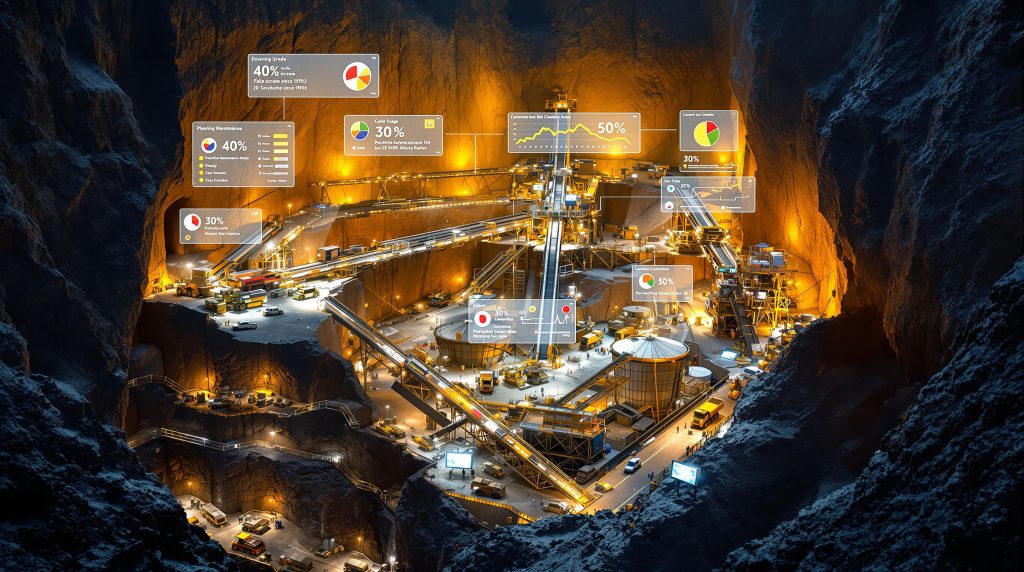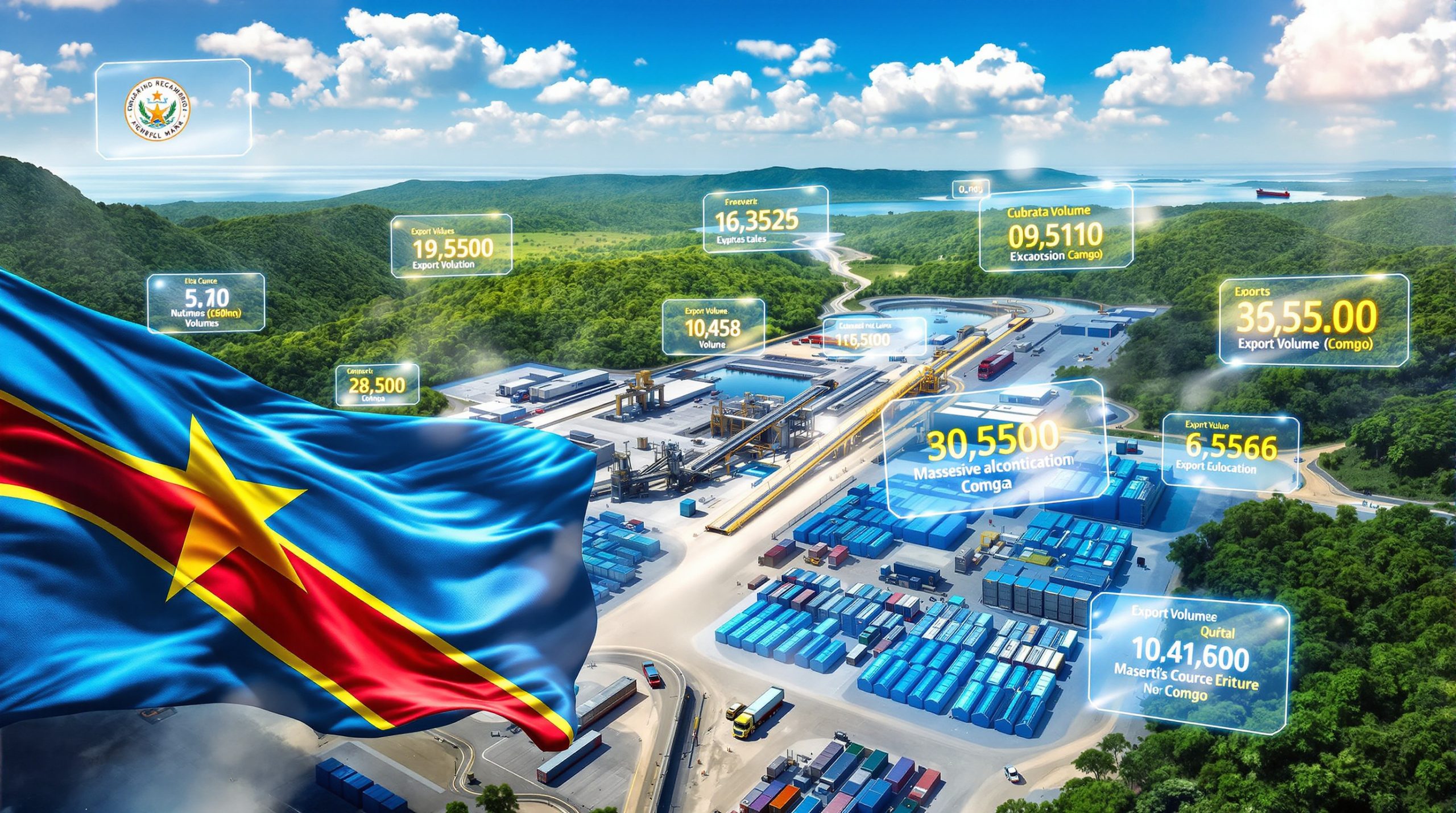What is Operational Complexity in Mining and Why Does It Matter for 2026?
Mining operations today face an unprecedented convergence of technical, logistical, and management challenges that collectively define operational complexity in mining 2026. This internal web of difficulties encompasses everything from equipment reliability and resource quality to workforce coordination and infrastructure limitations. Unlike external market forces or regulatory pressures, operational complexity emerges from within mining companies themselves, directly impacting their ability to maintain consistent, profitable production.
The significance of operational complexity in mining 2026 has reached a tipping point. According to industry risk assessments, this challenge has displaced traditional concerns such as commodity price volatility, geopolitical tensions, and regulatory compliance to become the mining sector's primary strategic focus. This shift represents a fundamental transformation in how mining executives approach business planning and resource allocation.
The emergence of operational complexity as the top priority reflects the industry's recognition that internal inefficiencies now pose greater threats to performance than external market conditions. Furthermore, mining companies increasingly understand that sustainable success depends on mastering the intricate operational fundamentals rather than merely responding to external pressures through data-driven operations.
This strategic realignment signals a maturation in mining industry thinking. Companies are moving beyond reactive management approaches toward proactive optimization of their core operational capabilities. The focus has shifted from managing around external constraints to building robust internal systems capable of delivering consistent results regardless of external conditions.
How Declining Ore Quality is Reshaping Mining Operations
The Mathematics of Resource Deterioration
Mining operations worldwide confront a stark mathematical reality that fundamentally alters their economic equations. Copper ore concentrations have declined approximately 40% since 1991, forcing companies to process dramatically larger volumes of material to extract equivalent metal quantities. This degradation creates cascading effects throughout mining value chains.
The deterioration manifests in multiple operational dimensions:
• Processing volume expansion requiring larger equipment fleets and substantially higher energy consumption
• Extended processing cycles that reduce overall facility throughput and capacity utilisation
• Elevated waste-to-ore ratios demanding expanded tailings management infrastructure and disposal costs
• Transportation cost inflation due to increased material handling requirements across mining systems
Infrastructure Strain and Systematic Bottlenecks
As ore quality continues declining, existing mining infrastructure faces unprecedented operational stress. Transportation networks, processing facilities, and logistics systems originally designed for higher-grade materials now operate significantly beyond their optimal parameters. In addition, rail and plant capacity have emerged as particularly critical barriers to maintaining throughput as companies struggle with lower-grade ore processing requirements.
This infrastructure mismatch creates systematic bottlenecks that compound throughout mining supply chains. Equipment utilisation rates frequently exceed design specifications, accelerating wear patterns and increasing maintenance requirements. The resulting inefficiencies ripple through entire operations, affecting everything from production scheduling to cost management.
Mining companies report infrastructure capacity constraints as increasingly limiting factors in achieving production targets. The challenge extends beyond simple capacity expansion, requiring fundamental reconfiguration of processing and transportation systems to handle the higher volumes associated with lower-grade ores.
Why Equipment Aging Creates Cascading Operational Challenges
The Maintenance Discipline Crisis
A concerning trend has emerged across global mining operations where maintenance discipline deteriorates as short-term cost reduction measures take precedence over preventive maintenance programmes. This pattern persists despite compelling evidence that optimal maintenance strategies can deliver cost savings of up to 15% and substantially extend equipment operational life.
The maintenance challenge reflects broader operational complexity in mining 2026, where immediate cost pressures override long-term operational optimisation. Companies consistently underinvest in preventive maintenance despite documented evidence of its financial benefits and operational improvements through effective automation solutions.
Canadian Mining Success Case:
Industry analysis reveals documented instances where systematic maintenance discipline extended heavy truck operational life from 80,000 hours to 170,000 hours, effectively doubling equipment lifespan through proper care protocols. This example demonstrates the substantial operational improvements achievable through disciplined maintenance approaches.
Asset Lifecycle Management Complexities
Aging mining assets present increasingly complex operational challenges across multiple dimensions:
| Challenge Category | Operational Impact | Management Complexity |
|---|---|---|
| Unplanned Equipment Failures | 15-25% production capacity loss | High – requires predictive analytics implementation |
| Component Availability | Extended repair timelines | Medium – demands inventory optimisation strategies |
| Safety Compliance Requirements | Increased risk exposure levels | High – intensified regulatory oversight |
| Energy Efficiency Decline | 10-30% higher consumption rates | Medium – limited retrofit opportunities |
The interconnected nature of these challenges means that aging equipment problems compound exponentially rather than linearly. Consequently, a single component failure can cascade through interconnected systems, creating operational disruptions far exceeding the immediate equipment problem.
What Role Does Planning-Execution Misalignment Play?
The 30% Alignment Problem
Research reveals a fundamental disconnect in mining operations where alignment between planning departments and operational execution teams reaches as low as 30% in some operations. This severe misalignment undermines production predictability and significantly erodes investor confidence in mining companies' ability to meet guidance targets.
The low alignment rates reflect deeper organisational challenges where planning assumptions consistently fail to reflect operational realities. For instance, geological models may not account for processing constraints, production schedules ignore equipment availability, and quality control standards conflict with throughput requirements.
Functional Silos and Communication Breakdown
Traditional mining organisational structures organise around functional expertise including geology, engineering, processing, and logistics. While this structure provides technical depth, it frequently creates information silos that prevent holistic operational optimisation and integrated decision-making.
Common Misalignment Scenarios:
• Geological resource models that fail to reflect processing plant capabilities and limitations
• Production scheduling systems that inadequately account for equipment availability and maintenance requirements
• Quality control protocols that create conflicts with throughput optimisation targets
• Maintenance scheduling that disrupts planned production sequences without adequate coordination
These disconnects create operational inefficiencies where different departments optimise their individual functions without considering system-wide impacts. The result is suboptimal overall performance despite potentially strong individual departmental results.
How Rising Costs Are Amplifying Operational Pressure
The Hidden Productivity Decline
Cost pressures and productivity losses have moved sharply up industry risk rankings, rising from sixth to second place in recent assessments. While higher commodity prices in some sectors have boosted mining revenues, they have simultaneously masked underlying productivity declines driven by multiple structural cost increases.
The productivity challenge becomes particularly acute when commodity price improvements cannot offset the combined impact of rising energy costs, labour expense inflation, increased royalty payments, and trade tariff impacts. These structural pressures compound with operational complexity in mining 2026 challenges to create significant margin pressure.
Structural Cost Pressures
Mining companies face mounting pressure from multiple cost categories that continue escalating regardless of operational efficiency improvements:
Energy and Utilities Impact:
• Electricity price volatility directly affecting energy-intensive processing operations
• Fuel cost fluctuations impacting mobile equipment fleets and transportation systems
• Carbon pricing mechanisms adding environmental compliance costs across operations
Labour Market Dynamics:
• Skilled worker shortages driving wage inflation in specialised technical roles
• Remote location premiums increasing compensation costs for operations in isolated areas
• Technology training investments required for digital transformation initiatives
Regulatory Compliance Requirements:
• Environmental monitoring and reporting system investments
• Safety standard upgrades requiring certification process compliance
• Community engagement obligations and social licence maintenance costs
What Digital Solutions Are Addressing Operational Complexity?
Integrated Data-Driven Operations
Mining companies increasingly implement comprehensive digital platforms connecting geological modelling, production planning, equipment monitoring, and quality control systems. These integrated approaches enable real-time operational decision-making and predictive analytics capabilities that address multiple complexity challenges simultaneously.
Digital transformation initiatives focus on eliminating information silos and creating unified operational visibility. Furthermore, companies report that integrated platforms improve coordination between planning and execution teams while providing data-driven insights for optimisation decisions alongside current industry innovation trends.
Key Digital Innovation Areas:
• Predictive Maintenance Systems: Utilising sensor data and machine learning algorithms to anticipate equipment failures before they occur
• Autonomous Equipment Integration: Reducing human error variability and improving operational consistency through automated systems
• Real-Time Ore Quality Tracking: Optimising blending and processing decisions based on continuous quality monitoring data
• Integrated Planning Platforms: Connecting long-term strategic mine planning with daily operational execution requirements
Automation as a Complexity Solution
Automation technologies offer pathways to manage operational complexity by standardising processes, reducing variability, and improving consistency. However, automation implementation introduces new complexity challenges around system integration, cybersecurity requirements, and workforce transition management.
The most successful automation implementations focus on specific operational bottlenecks rather than comprehensive system replacement. Companies find that targeted automation delivers more manageable complexity reduction while providing measurable operational improvements.
How Are Mining Companies Adapting Their Capital Strategies?
The Shift from Greenfield to Brownfield Focus
Mining companies increasingly prioritise brownfield expansions over greenfield exploration projects, reflecting multiple operational complexity considerations and financial constraints. The industry continues favouring brownfield developments over greenfield exploration, reflecting longer development cycles hampered by regulation, sustainability requirements, and permitting challenges.
This strategic shift addresses operational complexity through several pathways:
• Established Geological Understanding: Existing operations provide comprehensive knowledge of resource characteristics and processing requirements
• Infrastructure Leverage: Utilising existing processing facilities, transportation networks, and utilities infrastructure
• Regulatory Familiarity: Operating within established permitting frameworks and compliance systems
• Workforce Expertise: Building upon existing operational knowledge and management capabilities
Joint Ventures and Strategic Partnerships
The mining industry's weighted average cost of capital has climbed to between 8% and 10%, more than double that of major technology sector peers. This elevated capital cost environment encourages companies to explore joint ventures and partnerships as methods to create long-term value while retaining cash reserves to capitalise on opportunities.
Recent strategic consolidation examples include major copper sector mergers, where companies aim to establish top-tier global production positions. These transactions represent pivotal moments for industry consolidation and portfolio optimisation as miners secure essential minerals and metals positions through evolving capital strategy trends.
Companies are increasing capital expenditure while reducing shareholder returns in an ongoing shift toward growth-focused strategies. This capital reallocation reflects recognition that operational excellence requires sustained investment rather than cost minimisation approaches.
Why Has Geopolitical Risk Dropped in Priority Rankings?
Asset and Market Reality Acceptance
Geopolitical factors have dropped to seventh place in mining industry risk rankings, representing a significant shift in strategic priorities. According to mining technology analysis, this ranking decline reflects the industry's acceptance that mining assets and, to some extent, markets are geographically fixed constraints that cannot be readily modified through strategic planning.
Unlike industries with flexible location options, mining companies must work within their existing geographical constraints and resource positions. This acceptance has shifted strategic focus from external risk avoidance toward building operational resilience within fixed geographic contexts.
Mining executives increasingly recognise that their primary assets and markets are located where geological resources exist, not where optimal business conditions exist. This reality requires different risk management approaches compared to industries with greater operational flexibility.
Long-Term Strategic Positioning
Despite lower immediate priority rankings, mining companies maintain vigilance regarding medium and long-term implications of tariffs and trade disruption. The strategic focus has evolved from reactive geopolitical risk management toward building robust relationships with local governments and communities as critical operational requirements.
Companies should remain alert to geopolitical uncertainty impacts, particularly trade policy changes that affect mineral export markets and supply chain operations. Building strong local relationships becomes essential for operational stability rather than optional community relations activity.
What Does Workforce Transformation Mean for Operational Complexity?
The Skills Gap Challenge
Workforce transformation has re-entered the top ten risk rankings at sixth place, reflecting mining operations' dual challenge of attracting new talent while retaining experienced personnel. Miners struggle to attract diverse workforces amid tight labour markets, particularly in specialised technical roles where operational knowledge directly impacts complexity management capabilities.
The skills gap becomes particularly acute in areas where operational complexity in mining 2026 demands sophisticated technical expertise:
Critical Skill Areas:
• Digital technology integration and advanced data analytics capabilities
• Sophisticated equipment maintenance and complex troubleshooting methodologies
• Process optimisation and continuous improvement system management
• Environmental compliance and advanced safety management protocols
Diversity and Inclusion Imperatives
Industry efforts to diversify workforces add additional operational complexity layers, requiring new recruitment strategies, workplace culture adaptations, and comprehensive training programme development. However, research consistently demonstrates that diverse teams exhibit superior problem-solving capabilities for complex operational challenges through enhanced diversity and inclusion initiatives.
The workforce transformation challenge extends beyond simple recruitment to encompass fundamental changes in how mining operations organise work, develop talent, and transfer knowledge between experienced and new employees. These changes require sustained investment and systematic approaches to be effective.
How Will Operational Complexity Shape Mining's Future?
The Innovation Imperative
Mining companies that successfully navigate operational complexity will likely emerge as industry leaders through systematic innovation across multiple operational dimensions. Success requires integrated systems thinking rather than isolated technological solutions or departmental improvements.
Miners are entering a new phase marked by operational risk, cost pressure, and geopolitical uncertainty, even as global demand for energy transition materials, defence metals, and data centre infrastructure continues growing. This environment demands significant sector transformation requiring enhanced innovation, collaboration, and organisational agility.
Strategic Innovation Areas:
• Integrated Systems Thinking: Viewing mining operations as interconnected systems rather than separate functional departments
• Adaptive Management Practices: Developing organisational capabilities to respond rapidly to changing operational challenges
• Technology Integration: Implementing digital solutions that enhance rather than complicate existing operational frameworks
• Collaborative Partnerships: Building strategic relationships with technology providers, research institutions, and industry peers
Competitive Advantage Through Complexity Management
Companies that successfully transform operational complexity from a risk factor into a competitive advantage will likely capture disproportionate value in the evolving mining landscape. This transformation requires sustained investment in human resources, operational processes, and integrated technology systems.
The mining industry's recognition of operational complexity in mining 2026 as its primary challenge represents a strategic maturation in management thinking. Rather than focusing primarily on external factors beyond their direct control, mining companies are prioritising the operational fundamentals that directly determine their performance outcomes.
Significant transformation of the mining sector continues gaining momentum, requiring companies to reimagine their operational approaches rather than incrementally improve existing systems. This is not a time for operational complacency but rather an opportunity to fundamentally restructure mining operations for enhanced performance and resilience.
Disclaimer: This article presents industry analysis based on publicly available information and should not be considered investment advice. Mining operations involve substantial risks, and operational complexity challenges may vary significantly between individual companies and projects. Readers should conduct independent research and consult qualified professionals before making investment or operational decisions.
Ready to Capitalise on Mining's Operational Transformation?
Whilst operational complexity reshapes the mining landscape, savvy investors recognise that companies successfully navigating these challenges often emerge as standout performers. Discovery Alert's proprietary Discovery IQ model identifies significant mineral discoveries instantly, helping you spot opportunities where operational excellence meets geological success across ASX mineral discoveries. Begin your 30-day free trial today and position yourself ahead of the market as mining companies transform complexity into competitive advantage.




